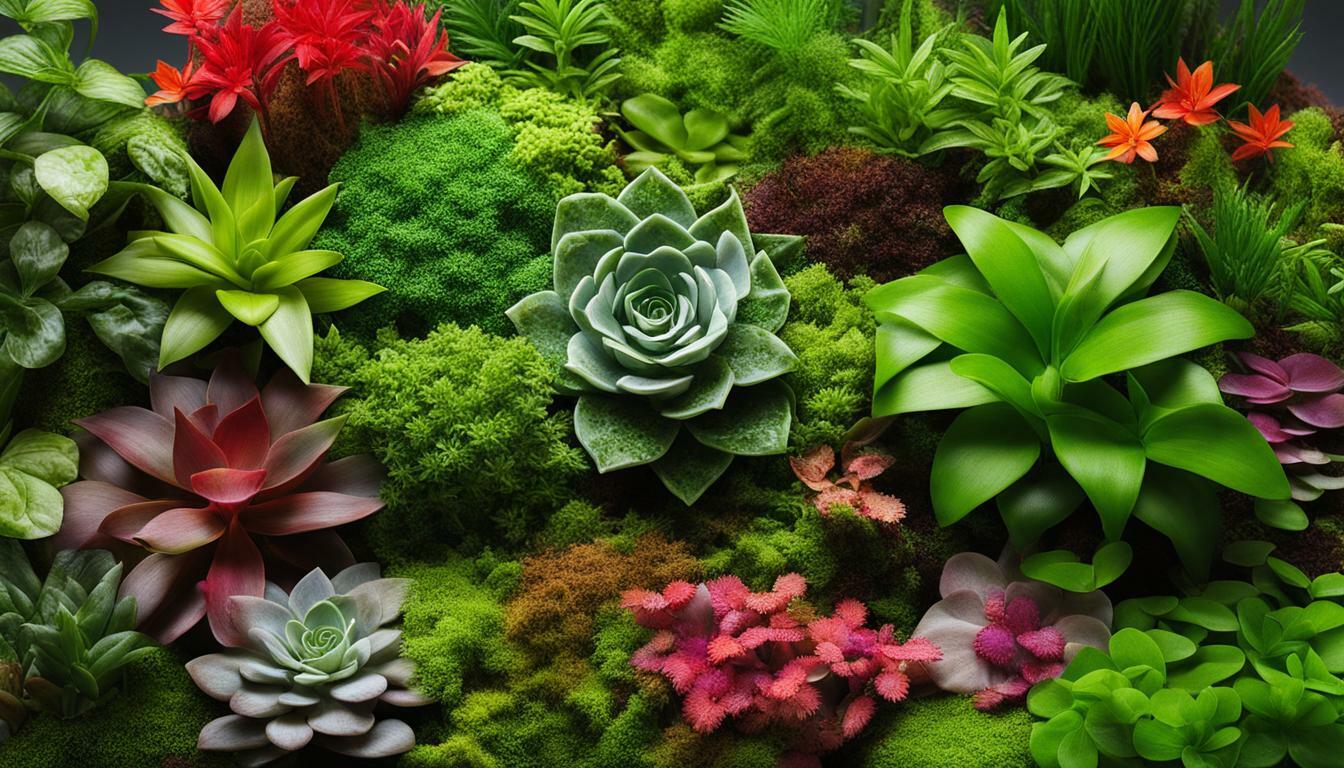Creating a vibrant and flourishing terrarium requires careful consideration of the optimal terrarium plants and ground cover plants. These miniature ecosystems bring a touch of nature into your home, but selecting the right plants is crucial for their success. Understanding the differences between open and closed terrariums, as well as the specific needs and requirements of the plants, will help you create a healthy and thriving environment.
Finding the perfect balance in a terrarium starts with knowing the distinction between open and closed terrariums. Open terrariums have lower humidity levels, require more ventilation, and are well-suited for arid plants like cacti and succulents. On the other hand, closed terrariums are enclosed, creating a humid environment that supports humidity-loving plants like ferns and prayer plants.
Lighting is another essential factor to consider when selecting terrarium plants. Closed terrariums typically thrive in low to medium light conditions, while open terrariums benefit from brighter but indirect light. Understanding the lighting needs of your chosen plants and matching them to the specific type of terrarium will contribute to their overall health and vitality.
Proper care practices are vital to maintaining a healthy terrarium ecosystem. This includes watering the plants appropriately, providing adequate ventilation to prevent excess moisture and mold, regular pruning to promote growth and aesthetics, and keeping the terrarium clean to avoid pests and diseases.
For open terrariums, air plants, haworthia, jade plants, button ferns, and string of pearls are excellent choices. These low-maintenance plants are well-suited for the arid conditions found in open terrariums and can thrive with minimal care.
In closed terrariums, ferns such as the artillery fern, aluminum plants, polka dot plants, and baby tears are ideal options. These humidity-loving plants flourish in the enclosed environment of closed terrariums and add a lush and vibrant touch to the miniature ecosystem.
When selecting the ground cover plants for your terrarium, it is important to choose species that have similar growing requirements. This ensures that all the plants in your terrarium can coexist harmoniously and thrive together. By considering factors such as light, water, and humidity, you can create a healthy and well-balanced terrarium ecosystem.
Key Takeaways:
- Optimal terrarium plants and ground cover plants are crucial for creating a healthy terrarium ecosystem.
- Understanding the differences between open and closed terrariums is essential for selecting the right plants.
- Open terrariums are suitable for arid plants, while closed terrariums support humidity-loving species.
- Matching plant light requirements to the specific type of terrarium promotes optimal growth and vitality.
- Proper care practices, including watering, ventilation, pruning, and cleaning, are necessary for maintaining a thriving terrarium.
Understanding the Difference Between Open and Closed Terrariums
Before selecting ground cover plants for your terrarium, it’s essential to understand the distinction between open and closed terrariums. These two types of terrariums have different humidity levels and ventilation needs, which directly impact the types of plants that thrive in each environment.
An open terrarium is a container that is not sealed and allows for air circulation. It is suitable for arid plants like cacti and succulents, which require less humidity. These plants prefer drier conditions and thrive in well-draining soil. Due to the lack of a sealed environment, open terrariums require minimal watering and less attention to humidity control.
On the other hand, closed terrariums are sealed containers that create a humid environment. They are ideal for humidity-loving plants like ferns and prayer plants, which require higher levels of moisture. The closed system traps moisture, creating a self-sustaining mini-ecosystem. These plants thrive in moist and well-draining soil, and the terrarium should be watered sparingly to maintain the proper humidity levels.
In addition to humidity, light requirements should also be considered when selecting plants for your terrarium. Closed terrariums thrive under low to medium light conditions, making them suitable for areas with indirect or filtered light. Open terrariums, on the other hand, can tolerate brighter but indirect light. It’s important to place your terrarium in a location that provides the appropriate light intensity for the selected plants.
Overall, understanding the differences between open and closed terrariums is crucial in selecting the right plants for your mini-ecosystem. By considering the humidity levels, ventilation needs, and light requirements, you can create a thriving and visually appealing terrarium that adds a touch of nature to your home.
Ideal Plants for Open Terrariums
Open terrariums offer a suitable environment for a range of low maintenance ground cover plants that thrive in arid conditions. These plants are excellent choices for those looking to create a vibrant terrarium ecosystem with minimal effort. Here are some of the best ground cover plants for open terrariums:
- Air Plants: Also known as Tillandsias, air plants are unique and beautiful additions to any open terrarium. They require very little water and can be attached to rocks or other decorative elements within the terrarium.
- Haworthia: Haworthia plants are succulent-like and boast striking rosette patterns. They are drought-tolerant and can thrive in bright, indirect light.
- Jade Plants: Jade plants are known for their thick, fleshy leaves and can add a touch of greenery to your open terrarium. They are hardy and can tolerate dry conditions.
- Button Ferns: Button ferns feature delicate fronds that create a beautiful cascading effect. They prefer moderate light conditions and thrive in humid environments.
- String of Pearls: With its cascading vines adorned with round, bead-like leaves, the String of Pearls is a popular choice for open terrariums. It requires bright, indirect light and infrequent watering.
These low maintenance ground cover plants not only add visual interest but also contribute to the overall health of your open terrarium. Their ability to thrive in arid conditions makes them ideal choices for those who prefer a hands-off approach to terrarium gardening.
Image:
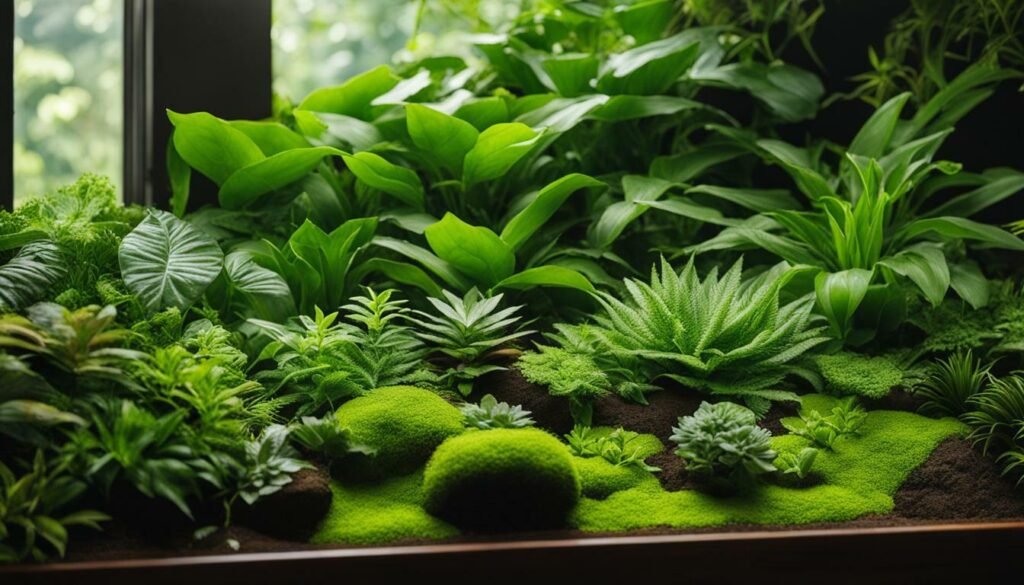
| Plant | Light Requirements | Watering Needs |
|---|---|---|
| Air Plants | Indirect Bright Light | Spritz with Water every 2-3 Weeks |
| Haworthia | Bright, Indirect Light | Water Sparingly every 2-3 Weeks |
| Jade Plants | Bright, Indirect Light | Allow Soil to Dry Between Waterings |
| Button Ferns | Moderate Light | Maintain Moist Soil |
| String of Pearls | Bright, Indirect Light | Water Infrequently; Allow Soil to Dry Out |
Remember to place your open terrarium in a well-lit area away from direct sunlight. Proper care and maintenance, including regular watering and occasional pruning, will help ensure the longevity of your terrarium and the health of its ground cover plants.
Recommended Plants for Closed Terrariums
Closed terrariums are perfect for cultivating ground cover plants that thrive in a humid and enclosed setting. These types of terrariums create a self-contained environment that retains moisture, allowing humidity-loving plants to flourish. If you’re looking to create a closed terrarium, here are some recommended ground cover plants that will thrive in this unique ecosystem:
- Artillery Fern (Pilea microphylla): This low-growing plant features delicate, round leaves that add a touch of elegance to any closed terrarium. It prefers indirect light and thrives in high humidity.
- Aluminum Plant (Pilea cadierei): Known for its distinctive silver markings on dark green leaves, the aluminum plant is a popular choice for closed terrariums. It prefers moderate to bright indirect light and high humidity levels.
- Polka Dot Plant (Hypoestes phyllostachya): With its eye-catching pink, white, or red speckled leaves, the polka dot plant adds a pop of color to closed terrariums. It thrives in bright, indirect light and humid environments.
- Baby Tears (Soleirolia soleirolii): This delicate, trailing plant features tiny leaves that create a lush carpet effect in closed terrariums. It prefers bright, indirect light and constant moisture.
When choosing ground cover plants for closed terrariums, it’s important to consider their size and growth habits. Select plants that will stay small and compact to ensure they don’t overcrowd the terrarium over time. Additionally, regularly monitor the humidity levels and moisture content in your closed terrarium to provide the optimal conditions for these plants to thrive.
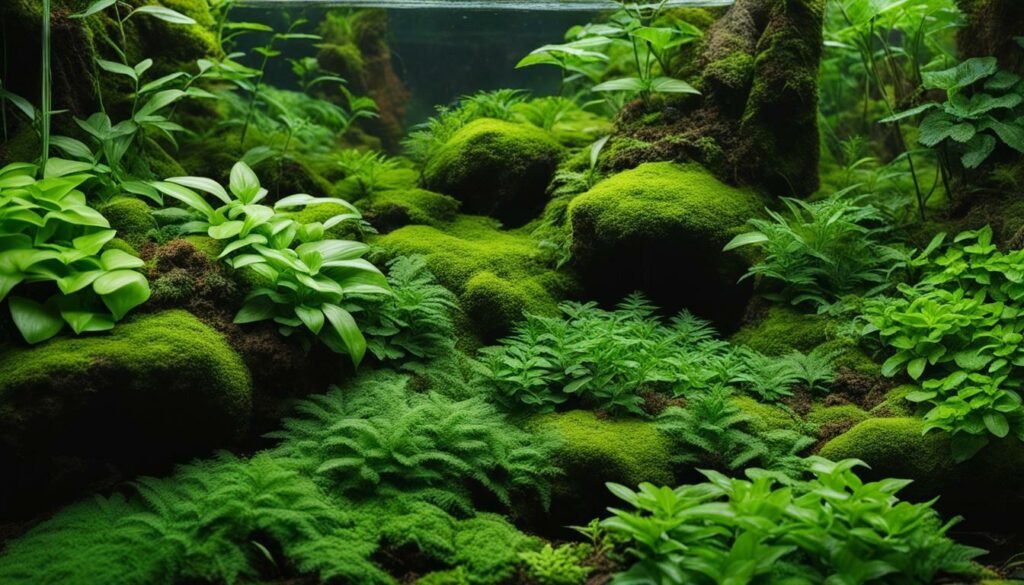
| Plant | Light Requirements | Humidity Levels |
|---|---|---|
| Artillery Fern (Pilea microphylla) | Indirect light | High humidity |
| Aluminum Plant (Pilea cadierei) | Moderate to bright indirect light | High humidity |
| Polka Dot Plant (Hypoestes phyllostachya) | Bright, indirect light | Humid environments |
| Baby Tears (Soleirolia soleirolii) | Bright, indirect light | Constant moisture |
By choosing the right ground cover plants for your closed terrarium, you can create a vibrant and lush ecosystem. These plants not only add beauty and visual interest but also contribute to the overall health of the terrarium by maintaining humidity levels and purifying the air. With proper care and attention, your closed terrarium will become a captivating miniature world teeming with life.
Matching Plant Light Requirements to Terrarium Types
Properly matching the light requirements of your chosen ground cover plants to the type of terrarium is crucial for their overall health and growth. Terrariums, whether open or closed, provide a controlled environment for plants to thrive in. Lighting plays a significant role in this, as it directly affects the photosynthesis process and the plant’s ability to produce energy.
In open terrariums, where the light is more direct, low to medium light plants are recommended. These plants are typically found in arid climates and are accustomed to receiving plenty of sunlight. Examples of low maintenance terrarium plants suitable for open terrariums include air plants, haworthia, jade plants, button ferns, and string of pearls. These plants can tolerate slightly drier conditions and will benefit from the bright but indirect light available in an open terrarium.
Closed terrariums, on the other hand, provide a more humid environment due to the enclosed nature of the container. The optimal lighting conditions for closed terrariums are low to medium indirect light. This type of light mimics the filtered light found in shaded areas of the rainforest. Ferns, such as artillery ferns, aluminum plants, polka dot plants, and baby tears, are excellent choices for closed terrariums. These plants thrive in the higher humidity levels and lower light levels found in this type of terrarium setting.
| Open Terrarium Plants | Closed Terrarium Plants |
|---|---|
| Air Plants | Artillery Ferns |
| Haworthia | Aluminum Plants |
| Jade Plants | Polka Dot Plants |
| Button Ferns | Baby Tears |
| String of Pearls |
By understanding the lighting needs of your chosen ground cover plants and selecting the appropriate type of terrarium, you can provide the ideal conditions for their growth and ensure a healthy and harmonious terrarium ecosystem. Remember to monitor the light levels in your terrarium and make adjustments as necessary to maintain optimal conditions for your plants.
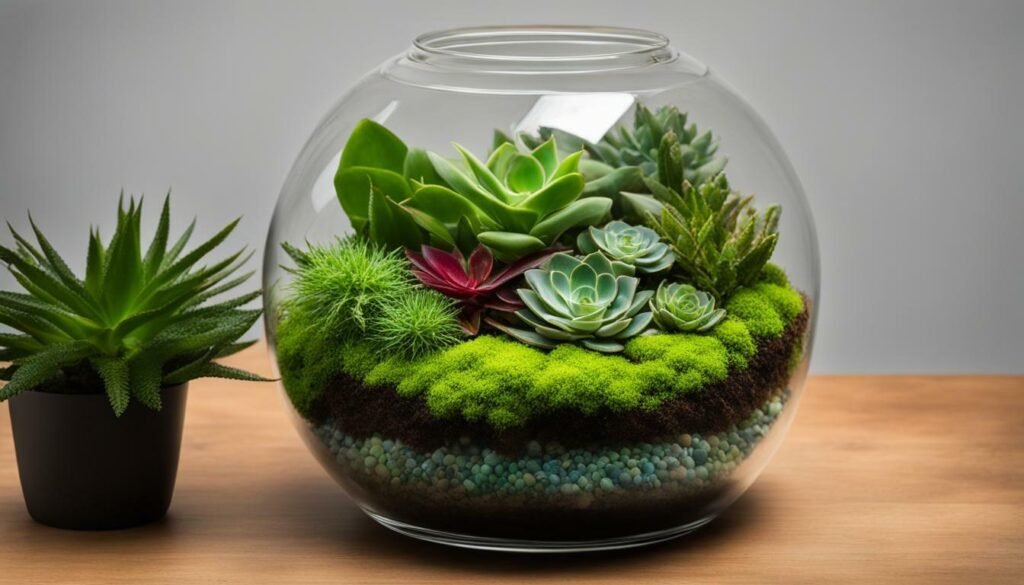
Choosing low maintenance terrarium plants that are suitable for your specific type of terrarium will make terrarium gardening an enjoyable and rewarding experience. Whether you opt for an open or closed terrarium, there are numerous plant options available to create a stunning miniature ecosystem in your home. Consider the light requirements, humidity levels, and overall care needs of your chosen plants to create a thriving and beautiful terrarium garden.
Essential Care Practices for Terrariums
To ensure a thriving terrarium ecosystem, it’s important to follow essential care practices that promote healthy growth and prevent issues. Proper watering, ventilation, pruning, and cleaning are crucial for maintaining a balanced and harmonious environment. Here are some tips to help you care for your terrarium:
- Watering: Terrariums require careful watering to avoid overwatering or underwatering. Check the moisture level of the soil regularly and only water when it feels dry to the touch. Use a spray bottle or a watering can with a narrow spout to avoid excessive water accumulation.
- Ventilation: Proper airflow is essential for preventing mold and fungal growth in closed terrariums. Open the lid occasionally to allow fresh air to circulate. In open terrariums, ensure that the plants are not overcrowded, as good airflow will help prevent the development of pests and diseases.
- Pruning: Regular pruning is necessary to maintain the shape and size of the plants in your terrarium. Remove any dead or yellowing leaves, as well as any overgrown branches that may be blocking light or airflow. Trim back fast-growing plants to prevent them from overshadowing others.
- Cleaning: Keep your terrarium clean by removing any fallen leaves, debris, or dead plant matter. Use a small brush or a soft cloth to gently clean the glass walls of the terrarium to maintain its visual appeal.
Following these care practices will help create a healthy and thriving terrarium ecosystem. Remember to observe your plants closely and make adjustments as needed. With the right care and attention, your terrarium will continue to bring beauty and a touch of nature into your home.
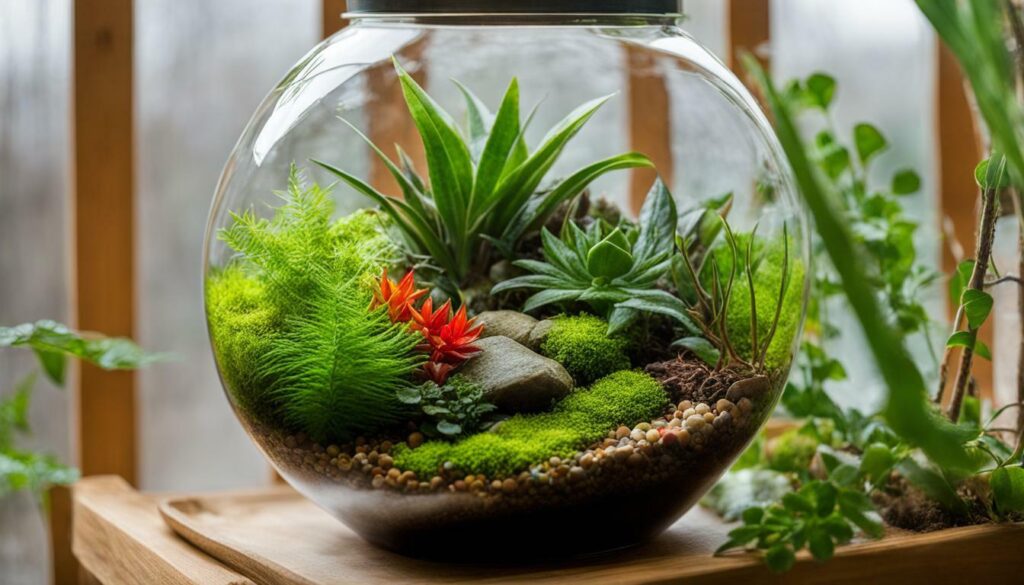
| Plant Type | Watering Frequency |
|---|---|
| Succulents and Cacti | Every 2-3 weeks |
| Ferns and Moss | Once a week |
| Air Plants | Twice a week |
| Tropical Plants | Once every 3-4 days |
Remember that these watering frequencies are general guidelines, and you should adjust them based on the specific needs of your plants and the moisture level within your terrarium. Monitoring the soil moisture and observing the health of your plants will help you determine the optimal watering schedule.
Air Plants and Other Suitable Options for Open Terrariums
When selecting ground cover plants for your open terrarium, consider air plants and other suitable options known for their resilience and unique appearance. Air plants, also known as Tillandsias, are epiphytic plants that don’t need soil to grow. They can thrive in open terrariums as they absorb water and nutrients through their leaves. Air plants come in various shapes and sizes, adding a touch of whimsy to your terrarium. Their low maintenance requirements make them perfect for busy plant enthusiasts.
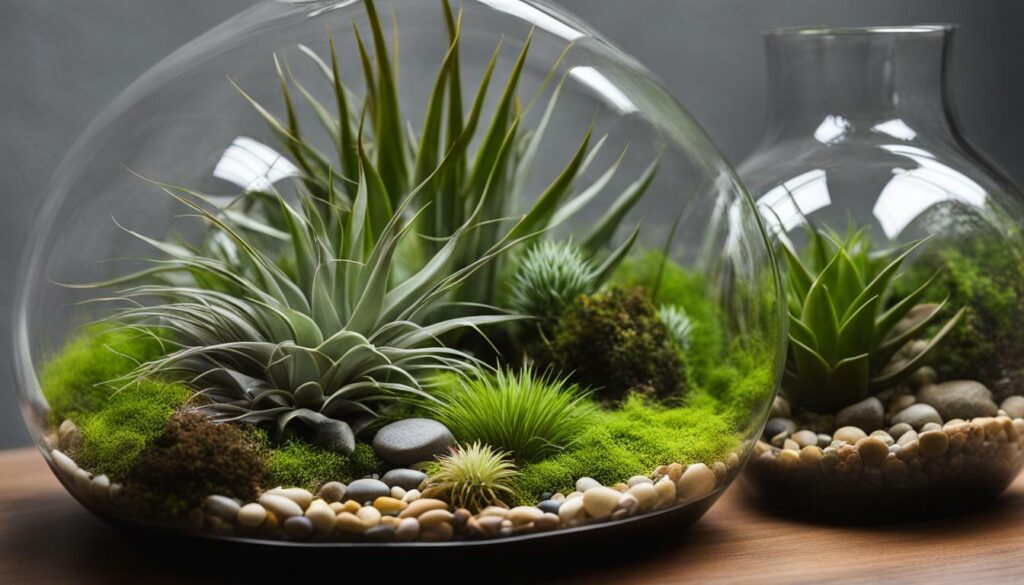
Aside from air plants, other suitable options for open terrariums include haworthia, jade plants, button ferns, and string of pearls. These plants are known for their ability to withstand arid conditions and require minimal care. Haworthia, with its striking architectural leaves, adds an interesting texture to your terrarium. Jade plants, with their thick, fleshy leaves, are drought-tolerant and add a touch of elegance. Button ferns and string of pearls are both trailing plants that provide a cascading effect, creating a visually appealing terrarium. These plant options offer a wide variety of colors, textures, and shapes, allowing you to create a personalized and eye-catching terrarium display.
When arranging your open terrarium, consider the height and growth habits of the plants. Place taller plants towards the back and trailing plants towards the front to create depth and visual interest. Mix and match different plant varieties to create an aesthetically pleasing arrangement. Remember to provide adequate light, water, and airflow to ensure the health and longevity of your open terrarium plants. With the right plant selection and care, you can create a beautiful and thriving miniature garden right in your own home.
Ferns and Other Ideal Choices for Closed Terrariums
Closed terrariums can host a variety of ground cover plants, including ferns and other suitable choices that thrive in high humidity environments. These plants are well-adapted to the moisture-rich conditions inside closed terrariums, making them beautiful additions to your indoor garden. Ferns, in particular, are known for their lush foliage and ability to create a serene and verdant atmosphere.
Ferns come in various shapes and sizes, making them versatile options for closed terrariums. Some popular choices include artillery ferns, aluminum plants, polka dot plants, and baby tears. These plants not only add a touch of elegance and beauty to your terrarium, but they also help maintain the humidity levels necessary for a thriving closed ecosystem.
When selecting ferns or other ground cover plants for your closed terrarium, it’s essential to consider their specific care requirements. Most ferns prefer indirect, filtered light, so placing your closed terrarium in a location with bright but indirect light is ideal. Additionally, these plants thrive in consistently moist soil, so regular watering is necessary to keep them healthy.
| Plant | Light Requirements | Watering Needs |
|---|---|---|
| Artillery Fern | Indirect, filtered light | Consistently moist soil |
| Aluminum Plant | Indirect, filtered light | Consistently moist soil |
| Polka Dot Plant | Indirect, filtered light | Consistently moist soil |
| Baby Tears | Indirect, filtered light | Consistently moist soil |
With their delicate fronds and vibrant green hues, ferns and other ground cover plants can transform your closed terrarium into a lush and enchanting miniature world. The combination of high humidity and suitable lighting conditions create the perfect environment for these plants to thrive. By choosing ferns and other ideal choices for closed terrariums, you can enjoy the beauty of nature indoors while creating a healthy and harmonious ecosystem.
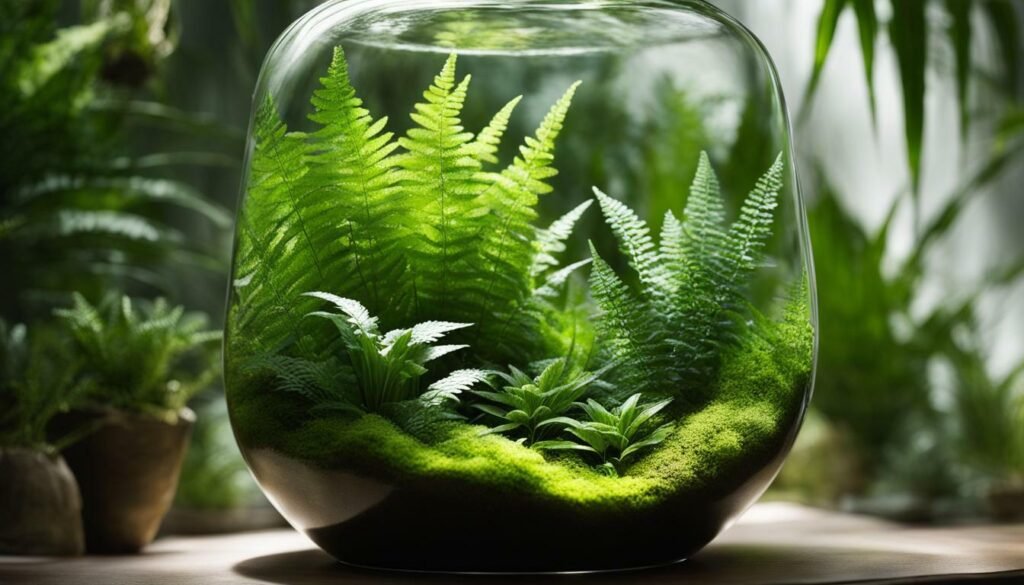
Selecting ground cover plants with similar growing requirements is essential for creating a healthy and harmonious terrarium ecosystem. When choosing plants for your terrarium, consider factors such as humidity levels, lighting conditions, and maintenance needs. By selecting plants that thrive in similar environments, you can ensure that your terrarium remains balanced and sustainable.
In open terrariums, where humidity levels are lower, it’s important to choose ground cover plants that can withstand arid conditions. Species such as air plants, haworthia, jade plants, button ferns, and string of pearls are well-suited for these environments. They require minimal watering and can tolerate moderate light, making them ideal choices for open terrariums.
On the other hand, closed terrariums have higher humidity levels, creating a more tropical environment. For these terrariums, selecting plants that thrive in high humidity is crucial. Ferns, such as artillery ferns and maidenhair ferns, are excellent options, as well as plants like aluminum plants, polka dot plants, and baby tears. These species enjoy the humid conditions within closed terrariums and can bring lush greenery to your miniature ecosystem.
Remember to consider lighting requirements as well. Closed terrariums typically thrive under low to medium light conditions, while open terrariums benefit from brighter but indirect light. Matching the lighting needs of your plants to the specific type of terrarium will promote optimal growth and overall health.
Table: Recommended Ground Cover Plants for Terrariums
| Open Terrariums | Closed Terrariums |
|---|---|
| Air plants | Ferns |
| Haworthia | Artillery ferns |
| Jade plants | Aluminum plants |
| Button ferns | Polka dot plants |
| String of pearls | Baby tears |
Remember to provide proper care for your terrarium plants, including regular watering, ensuring adequate ventilation, pruning when necessary, and keeping the terrarium clean. With the right selection of ground cover plants and diligent care practices, your terrarium can thrive and create a beautiful and healthy ecosystem right in your own home.
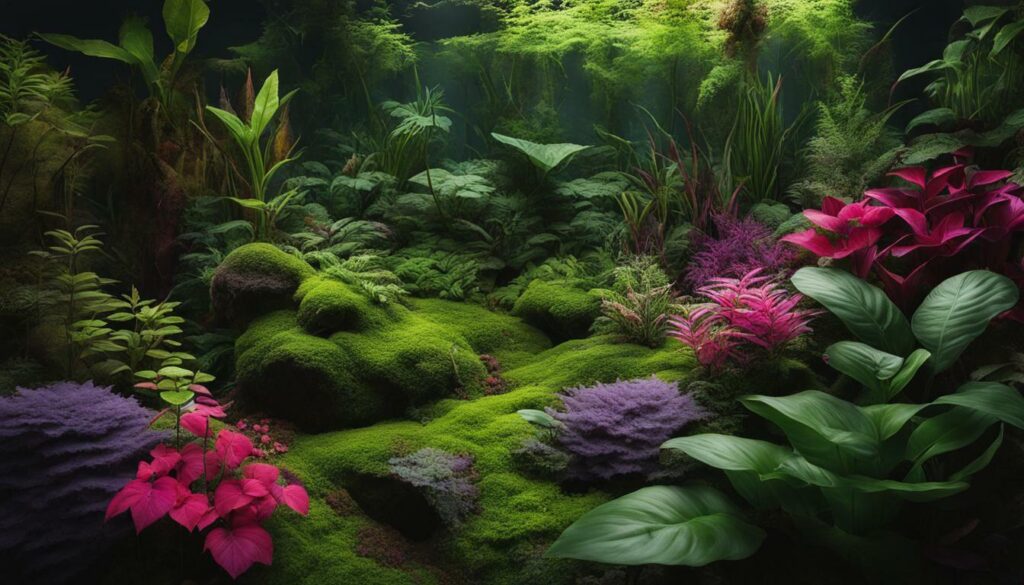
To recap, selecting and caring for ground cover plants in your terrarium requires attention to key factors to ensure a successful and thriving ecosystem. Here are some essential tips to guide you:
- Consider the type of terrarium: Determine whether you have an open or closed terrarium, as this will dictate the plants that can thrive in your specific environment. Open terrariums are suitable for arid plants, while closed terrariums support humidity-loving species.
- Match light requirements: Light is a crucial factor for plant growth in terrariums. Choose plants that can thrive in the lighting conditions of your terrarium. Low to medium light is ideal for closed terrariums, while open terrariums benefit from brighter but indirect light.
- Care for watering needs: Proper watering is essential for the health of your terrarium plants. Take care not to overwater or underwater, as both can be detrimental. It’s best to water sparingly and adjust the frequency based on the specific needs of your chosen plants.
- Ensure proper ventilation: While closed terrariums require minimal ventilation, open terrariums need more airflow to maintain a healthy environment. Regularly open the lid or remove the covering to allow for fresh air circulation.
- Consider compatibility: Select plants with similar growing requirements to create a harmonious terrarium ecosystem. This ensures that all plants can thrive and coexist in the same environment without competing for resources.
By following these tips, you can create a beautiful and sustainable terrarium ecosystem that will bring joy and tranquility to your living space.
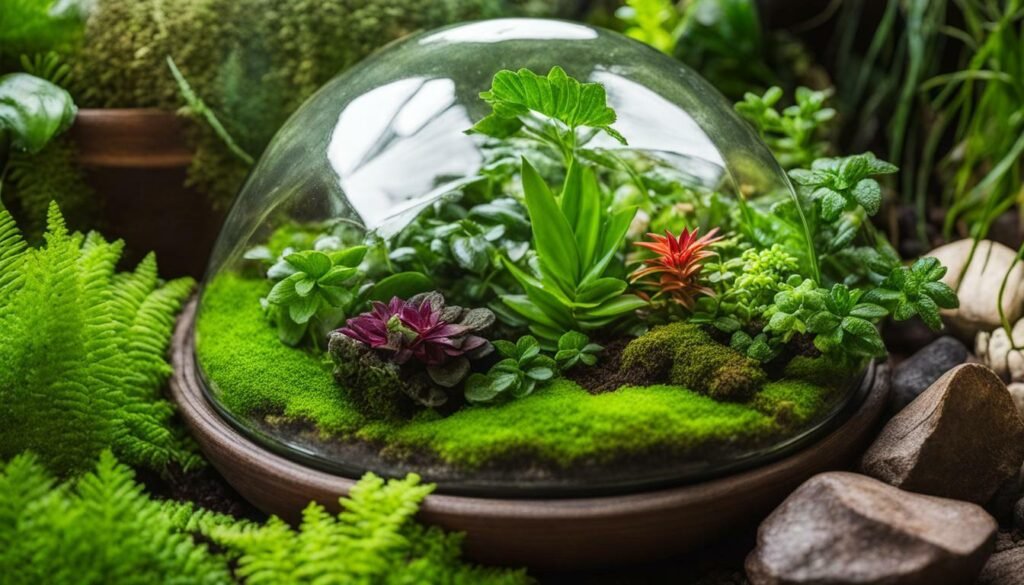
Proper care practices are essential for maintaining a healthy terrarium. Here are some key guidelines to keep in mind:
- Watering: Water your terrarium sparingly, allowing the soil to dry out partially between waterings. Overwatering can lead to root rot, while underwatering can cause the plants to wither. Use a mister or watering can with a narrow spout to water directly at the base of the plants.
- Pruning: Regularly trim any dead or yellowing leaves to maintain the overall health and appearance of your terrarium. Pruning also helps control the growth and spread of plants to prevent overcrowding.
- Cleaning: Remove any debris, dust, or mold that may accumulate in your terrarium. Wipe the glass walls with a damp cloth and gently brush off any dirt or dust from the plants and soil surface. This helps maintain a clean and visually appealing terrarium.
- Positioning: Place your terrarium in an area that receives the appropriate amount of light for the type of plants you have chosen. Avoid placing it in direct sunlight, as this can cause excessive heat and damage to the plants.
By following these care practices, you can ensure the long-term health and vitality of your terrarium ecosystem.
Terrarium Plants Ground Cover Plants for Healthy Ecosystems – Practical Tips
To help you choose the most suitable ground cover plants for your terrarium, here are some practical tips for assessing compatibility and tailoring your selection accordingly.
1. Consider the terrarium’s environment: Take into account the humidity levels, ventilation, and lighting conditions of your terrarium. Closed terrariums require higher humidity and indirect light, making them ideal for ferns and other moisture-loving plants. Open terrariums, on the other hand, have lower humidity and can accommodate arid plants like cacti and succulents that prefer brighter but indirect light.
2. Research plant characteristics: Before selecting ground cover plants, research their specific growth requirements. Consider factors such as watering needs, temperature tolerance, and growth rate. Choosing plants with similar requirements will ensure they thrive together and create a harmonious ecosystem within your terrarium.
3. Assess plant size and growth habit: Take note of the plant’s mature size and growth habit. Some ground cover plants spread quickly and can become invasive, crowding out other plants in your terrarium. Be mindful of space limitations and choose plants that will remain compact and well-behaved.
4. Look for low-maintenance options: If you’re new to terrarium gardening or prefer low-maintenance plants, consider selecting ground cover plants that are known for their durability and ease of care. Plants like air plants, jade plants, and polka dot plants are excellent choices that require minimal attention and can tolerate a range of conditions.
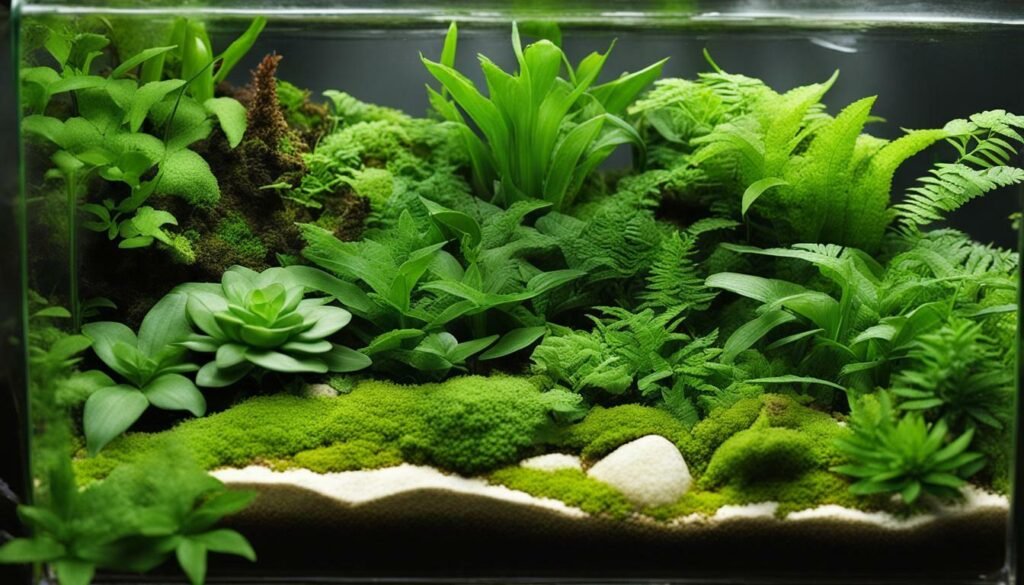
Choosing the right ground cover plants for your terrarium is essential for creating a healthy and thriving ecosystem. Consider the terrarium’s environment, research plant characteristics, assess plant size and growth habit, and look for low-maintenance options. By following these practical tips, you can select the most suitable plants for your terrarium and enjoy a beautiful and sustainable mini world in your home.
| Ground Cover Plants for Open Terrariums | Ground Cover Plants for Closed Terrariums |
|---|---|
| Air plants | Artillery ferns |
| Haworthia | Aluminum plants |
| Jade plants | Polka dot plants |
| Button ferns | Baby tears |
| String of pearls |
Conclusion
Selecting the right ground cover plants for your terrarium is essential for creating a healthy and thriving miniature ecosystem in your home. Whether you have an open terrarium or a closed one, understanding the differences in humidity levels and ventilation requirements is crucial. Open terrariums are well-suited for arid plants like cacti and succulents, which thrive in drier conditions. On the other hand, closed terrariums provide a humid environment that is perfect for humidity-loving plants such as ferns and prayer plants.
Another important consideration when choosing terrarium plants is the lighting requirements. Closed terrariums do well with low to medium light, while open terrariums benefit from brighter, indirect light. By matching the lighting conditions to your terrarium type, you can ensure that your plants receive the optimum amount of light for their growth and development.
Proper care practices, such as watering, ventilation, pruning, and cleaning, are vital for maintaining a healthy terrarium ecosystem. Regularly monitoring and adjusting these factors will help keep your plants happy and thriving. Additionally, it is important to select ground cover plants that have similar growing requirements to create a harmonious terrarium environment. Compatibility between plants ensures optimal growth and longevity for your terrarium.
Some recommended ground cover plants for open terrariums include air plants, haworthia, jade plants, button ferns, and string of pearls. These plants are well-suited for drier conditions and require minimal maintenance. For closed terrariums, ferns like the artillery fern, aluminum plant, polka dot plant, and baby tears are excellent choices. These plants thrive in the humid environment of closed terrariums and add a lush, green touch to your miniature ecosystem.
In conclusion, selecting the right ground cover plants for your terrarium is crucial for creating a healthy and thriving ecosystem. By understanding the differences between open and closed terrariums, considering lighting requirements, and implementing proper care practices, you can cultivate a beautiful and sustainable miniature garden in your home. Enjoy the process of creating and maintaining your terrarium as you witness the beauty of nature in a small, self-contained space.
Are Orchids Suitable as Ground Cover Plants in a Terrarium Ecosystem?
Yes, growing orchids in terrariums is a great way to add height and visual interest to the ecosystem. However, orchids may not be suitable as ground cover plants in a terrarium due to their specific light and humidity requirements. It’s best to choose low-growing plants that thrive in the unique conditions of a terrarium.
FAQ
What are the ideal plants for open terrariums?
Some ideal plants for open terrariums include air plants, haworthia, jade plants, button ferns, and string of pearls.
What are the recommended plants for closed terrariums?
Recommended plants for closed terrariums include artillery ferns, aluminum plants, polka dot plants, and baby tears.
How do I match plant light requirements to terrarium types?
For open terrariums, brighter but indirect light is ideal, while closed terrariums thrive in low to medium light conditions.
What are some essential care practices for terrariums?
Essential care practices include proper watering, ventilation, pruning, and cleaning.
What are some suitable options for open terrariums?
Suitable options for open terrariums include air plants, haworthia, jade plants, button ferns, and string of pearls.
What are some ideal choices for closed terrariums?
Ideal choices for closed terrariums include ferns, artillery ferns, aluminum plants, polka dot plants, and baby tears.
How can I create a healthy and harmonious terrarium ecosystem?
Selecting ground cover plants with similar growing requirements ensures a healthy and harmonious terrarium ecosystem.
What are some practical tips for selecting terrarium ground cover plants?
Practical tips include assessing plant compatibility and tailoring plant selection to specific terrarium needs.
Can you provide a summary of terrarium plant selection tips?
Key tips include choosing plants with similar requirements, considering the type of terrarium, and providing proper care practices.
What is the importance of ground cover plants in terrariums?
Ground cover plants are essential for creating a healthy and thriving terrarium ecosystem.

